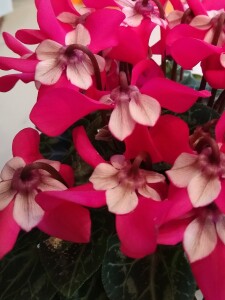 Every year at holiday time, florists’ cyclamen, known as Cyclamen persicum hybrids, proliferate in all the places that sell plants. Their bright colors–reds, pinks, purples, white and bi-colors—and showy, orchid-like blooms make them the ideal holiday eye candy. I generally buy one or two, either for my own house or as gifts for friends. Being a plant person, I also keep an eye out for new and different varieties. This year I found an especially lovely one that was also very different from traditional cyclamen.
Every year at holiday time, florists’ cyclamen, known as Cyclamen persicum hybrids, proliferate in all the places that sell plants. Their bright colors–reds, pinks, purples, white and bi-colors—and showy, orchid-like blooms make them the ideal holiday eye candy. I generally buy one or two, either for my own house or as gifts for friends. Being a plant person, I also keep an eye out for new and different varieties. This year I found an especially lovely one that was also very different from traditional cyclamen.
My new plant, which came in a six-inch pot, sports rose-pink and white flowers sitting high above the silver and green marbled foliage that is characteristic of cyclamen. The radical difference is in flower configuration. Typical cyclamen petals are reflexed or curled backwards, with the pointed tips of the rounded petals jutting out, or up, or both. Some people have compared the petals’ appearance to butterflies in flight.
The new cyclamen’s flowers face down. The five petals are in a daisy-like configuration, with smaller petal-like sepals lying flat atop the petals. The sepals are white, which contrasts nicely with the base petal color. This upside-down, flower-on-flower configuration means that the flower bases are easy to see from above the plant. The look is something akin to the top of a two-tone, wavy-edged beach umbrella.
In my part of the world cyclamen like my new acquisition didn’t exist last year. Twelve months ago, the new and different plants at retailers within my orbit had raveled edges, which made them very distinctive. I noticed an uncommonly large variety of miniature plants, with perfectly formed flowers in all the usual colors. I also found some normal-size plants that were highly fragrant, something that my new plant lacks completely.
A highly fragrant cyclamen with either ruffles or flower-on-flower shapes would be well worth saving even after the petals dropped. The heart-shaped foliage, marbled or mottled in gray or silver, makes the plant distinctive even when not in bloom.
So why do most people toss out their holiday cyclamens about the same time as they take down the holiday decorations? Many treat them as disposable decorations, but others are stymied by the care involved in getting the cyclamen to rebloom. This has happened to me more than once.
Sometimes this is not the fault of the unsuspecting plant buyer. Florist’s cyclamen, like other houseplants, are grown from seed under carefully monitored conditions. Growers orchestrate the growth cycle so the plants will flower at times when consumers are most likely to want them. It takes a lot of energy for a plant to do all of that, and sometimes the poor things are simply spent by the time the flowers depart.
If you want to try keeping your cyclamen, don’t kill it with kindness. Water only when the top of the soil feels quite dry, and avoid getting water near the plant’s crown, which can cause rot. Alternately, direct the water into the plant saucer, allowing the cyclamen to soak up moisture slowly, or stand the pot in water for about fifteen minutes, which will do the same thing. Most of the experts say that liquid houseplant fertilizer should be applied about every two weeks. Fertilizing more than that will ultimately gives you lots of leaves and very few flowers.
Now, for the some ominous news… If all goes well your plant will appear to die, probably in the spring. This is normal. Like humans, cyclamen need their rest. Unlike most humans, they drop everything—literally—and take it. Stop fertilizing and water sparingly while this eight to twelve week dormancy period lasts. You may see signs of rebirth at eight weeks, but if nothing has happened at the twelve week point, restart the watering and fertilizing routine. If you are lucky, your cyclamen will begin its growth cycle once again and eventually produce flowers.
If all your care and attention yields nothing, don’t fret. Gardeners should feel as little guilt as possible. A glut of guilt produces lots of headaches and few flowers. Instead, indulge in some bulbs of outdoor cyclamen—Cyclamen coum, for example—which take care of themselves and produce lovely little blooms that have the same configuration as their florist’s cyclamen cousins.
You can also look ahead to next winter, when breeders and merchandisers will undoubtedly offer something new and different in the holiday cyclamen category. The thrill of the new will force open your wallet and launch you on another cyclamen adventure.
